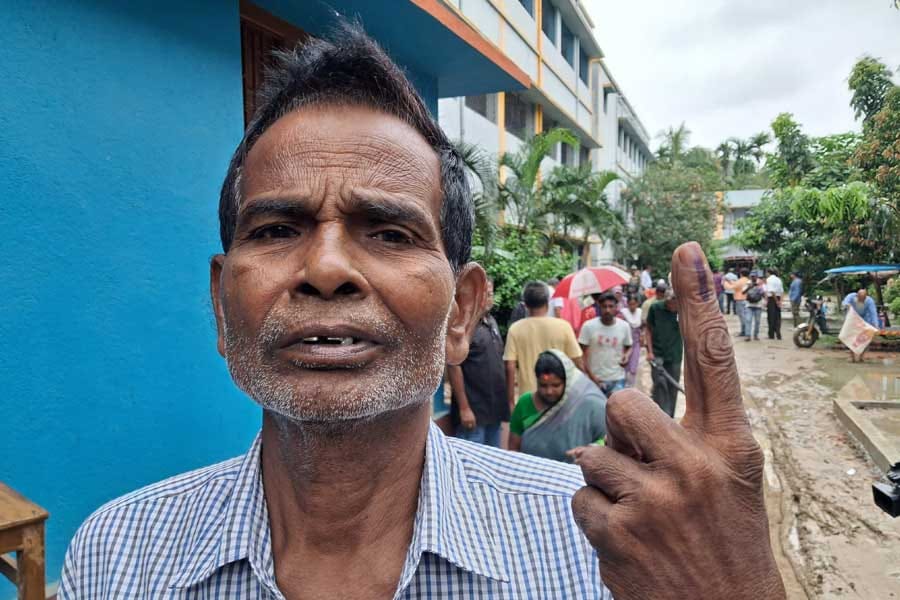 |
| The Cossipore clubhouse. Picture by Sanat Kumar Sinha |
The Seven Tanks Estate or Saat Pukur on Dum Dum Road is, as its name suggests, girdled by a number of tanks, although all seven of them are no longer in existence. Five of them have survived. Surrounded by high walls, the estate has the gateway giving on to the drive. Two bridges across a tank lead to the imposing double-storeyed building — an unlikely club house.
It boasts a grand pediment held aloft by a row of seven fluted columns with capitals of the Corinthian order. Unlike most palatial buildings in north or central Calcutta, whose style is usually cramped by new structures that have mushroomed around them, the Cossipore Club building — for that is the role that was assigned to it — plays prima donna to the hilt.
Even its wavering reflection in the tank is the very picture of perfection, till you have walked around the structure whose sheer volume makes you feel dwarfed. Then you discover that the columns on both sides have been joined together by a wall, small concrete boxes with glass windows have sprouted behind the pediment. A lift within a granite cage has been installed behind the building, to access the guest house for VIPs on the first floor.
Why a lift when the wooden staircase is so grand? But it is futile trying to reason with government offices. And what’s uglier, an obviously new structure juts out of the set of louvres at its rear, successfully shattering the harmony of the neo-classical building. All this in a structure that was included in the list of buildings that “require preservation and conservation in terms of the West Bengal Town and Country (Planning and Development) Act, 1979” way back in 1997.
Dum Dum may be a congested area but there is still plenty of open space in Seven Tanks estate with its tennis courts, and officers’ quarters with adjoining gardens. At some point of time some bright spark must have decided to make these additions to a perfect example of neo-classical architecture in a proper setting. Earlier, it used to be a 20-bigha plot. Now it is larger.
 |
| The grand staircase that leads to the VIP guest house on the first floor. Picture by Sanat Kumar Sinha |
The secretary of Cossipore Club, Sakti Prasad Sengupta, introduced me to Bimalendu Saha, the general manager of the Gun & Shell Factory, Cossipore, who was waiting in a ground-floor hall with wooden floors.
He related the history of the factory, a few minutes’ drive away — about 1.4km — adjacent to Chitteswari temple and overlooking the Hooghly. Saha said land for the country’s first defence factory was bought in 1801, and by March next year, it went into production.
Gun carriages belonging to the East India Company used to be repaired at Fort William. Then as the British became more deeply entrenched, it started to expand. The authorities began to look around for land that would be close to the fort and not far from the timber market of Chitpur either. From repairing gun carriages, when it was called Gun Carriage Agency, the factory graduated to Gun Foundry in 1830, thanks to the skill of the Indian artisans engaged in casting, turning and boring to produce barrels. Much later in 1905, it became the gun and shell factory.
Cossipore Club was set up in the same year for the recreation of Europeans and Anglo-Indian employees of ordnance factories and allied military establishments.
The ground-floor has been made over and only the dimensions of the halls and the wooden floor give away the age of the building.
The VIP guest house with six suites is wreathed in plastic creepers and sports a giant chandelier like an unfurled umbrella hanging upside down. The verandah is wide, and on the other side of Dum Dum Road beyond the club boundary, brick and cement cages wearing cellphone towers on their heads are coming up on all sides.
Debasis Bose, who specialises in Calcutta’s past, dug out its history. Saat Pukur originally belonged to Umanandan alias Nandalal Tagore, son of Harimohan Tagore of Pathuriaghat. Harimohan was the fourth son of the illustrious Darpanarayan Tagore. Nandalal’s mother in her old age had expressed the desire to visit Vrindavan. Going to faraway places on pilgrimage in those times was fraught with danger and there was no certainty of the pilgrim’s return.
So Nandalal decided to build a replica of Vrindavan close to Calcutta where his mother could rest in peace without realising that she was nowhere near Krishna’s pleasure ground.
He excavated the seven tanks and built a pleasure garden in imitation of the groves of Vrindavan. Hence its name Gupta Brindaban. He also constructed what is the club house now, and it has gone on record that Bishop Heber had been entertained here. The bishop described it as “more of an Italian villa”.
At some point of time, the property changed hands, and subsequently it was acquired by Ruplal Mallik, whose son-in-law was Raja Rajendra Mallik. The latter constructed Marble Palace to be one up on his father-in-law, who was rather vain about his Saat Pukur estate.
Saha quoted Rashbehari Mallik’s Bangsha Gourab chronicling the leading lights of the De Mallik clan of Subarna Banik caste which says the garden house belonged to honorary magistrate Shyamacharan Mallik, known as “Rothschild of the metropolis”. Shyamacharan was Ruplal’s son.
His residence that included a tank stood at 84 Upper Chitpur Road, next to what is known as Lohia Matri Sewa Sadan today. Nothing remains of his house save part of the gateway. At Dum Dum on December 27, 1869, Mallik had entertained the Duke of Edinburgh and had presented his majesty with gifts made of precious metals. The Duke of Edinburgh arrived here on board the Galatea on December 22 and disembarked at Prinsep Ghat. The date on which this estate was acquired for the factory is not documented. It is also not clear when the Tagores had sold off this sprawling estate.
The general manager’s quarters are adjacent to the factory on the bank of the Hooghly. It is a graceful double-storeyed building fronted by a garden and a private ghat. Shiva sits in the middle of the garden, a fountain squirting from his dreadlocks.











